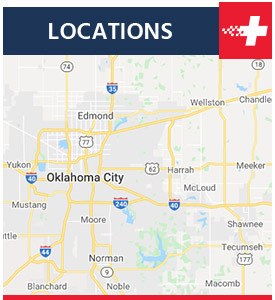Strains, Dislocations and Fracture Treatment Specialist at Immediate Care of Oklahoma
Immediate Care of Oklahoma has experienced staff that helps identify and treat these injuries. For more information, call us. We have convenient locations to serve you in Oklahoma City, OK.




Table of Contents:
What is a strain and a dislocation?
What is a fracture?
What do you mean by dislocation?
What complications can happen with a dislocation?
Strains, dislocations and fractures happen to most of us at one point in life. These can be minor injuries, or at times quite serious. Treatment of these injuries can help them to heal faster and prevent complications in the future.
We are familiar with the fact of what a broken bone or fracture is. Strains happen with a good deal of frequency. A strain/sprain is a stretching or tearing of tendons or ligaments. A dislocation is when a bone falls out of its joint. A visit to an urgent care center will help you know which you are dealing with.
Sprains and strains seem to be very similar, but they are really two different injuries. A sprain involves the ligaments. Ligaments are the fibrous tissue that connects bones together at the joints. A strain is the tearing or stretching of tendons. Tendons are the tissues that connect muscles to the bones.
Strains are injuries that are less severe than fractures or dislocations. Strains can often be treated with rest, ice, compression and elevation. They will typically get better in a few weeks. If it is stark enough, it may require surgery.
A dislocation happens when the bones in a joint separate. This can occur in any joint of the body. If it is only a partial dislocation, this is called a subluxation. Dislocations can be quite painful. A dislocation can cause the joint to be unsteady or even immobile. These can also cause damage to the tissues around the joint. Medical treatment for a dislocation is strongly recommended.
Sprains and strains will affect the soft tissue in the area of injury. Fractures do not necessarily affect those tissues. Fractures are a break or fissures in a bone. Open fractures are when the fragmented bone comes through the skin and can be seen. These are fairly easy to diagnose. Closed fractures are more difficult to identify due to the need for x-rays to locate them.
Fractures usually happen because of a sudden impact on the body causing the bone to break. There are fractures that can happen from repetitive use or stress. These are known as stress fractures. Fractures can cause pain, bruising and swelling. They can also create situations that can make it impossible to move that area. Moderate and mild fractures can be treated with casts or immobilizers. Severe fractures might require surgery to place screws, rods or other kinds of stabilizers.
Dislocations are quite common. They happen most frequently in the joints of the fingers, knee, shoulder, elbow, hip and jaw. A dislocation is caused by something that forces the bones in the joint to come apart. Accidents, falls and contact sports are the most common causes of dislocations. These can also happen if the muscles and tendons around a joint are weak and can become more frequent as we get older.
Treatment for dislocations will be based on how severe the injury is and which joint is affected. Keeping the joint elevated and applying an ice pack can help to reduce the pain.
Treatments for a dislocation include:
1. Medication to reduce the pain
2. Putting the bones back into place
3. Rest – after the bones are put back into place, they may need to be immobilized
4. Physical therapy to strengthen the ligaments and muscles around the affected joint.
5. Surgery may be required if the previous actions won’t work. It may also be required if the damage to the joint is more severe.
Most dislocations will not have serious or lasting complications. They will heal in a few weeks and life can go back to normal. In some cases, a dislocation can cause tears to the ligaments, tendons and muscles around the joint. In rare instances, it can cause bones to break. Surgery will likely be needed to repair this damage.
Severely dislocated joints can cause damage to blood vessels and nerves around the joint. When blood is not able to flow to the area, tissues may die. To minimize the damage, it is important to get the dislocated joints put back into place promptly by a doctor. Schedule an appointment online through our website or give us a call at one of our locations and we will book you in today at Immediate Care of Oklahoma! We serve patients from West Moore OK, Norman (HealthPlex) OK, Edmond OK, Yukon OK, I-240 & Sooner RD OK, Norman (24th) OK, Tecumseh OK, and Bethany OK.


Additional Services You May Need
▸ Urgent Care Services
▸ Illness + Injuries
▸ On Site Lab + X-Ray
▸ Helpful Health
▸ Motor Vehicle Accidents
▸ Drug Testing
▸ MRO
▸ UTI Treatment
▸ Employment Physicals
▸ Workers Comp
▸ Strep Throat Treatment
▸ Pregnancy Testing
▸ Blood Pressure Testing
▸ Urinalysis
▸ Mononucleosis Treatment
▸ Suture Removal
▸ Respiratory Syncytial Virus
▸ OccMed








